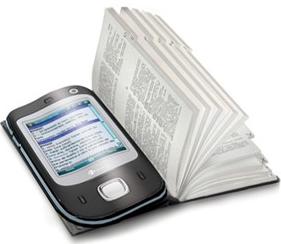Welcome to mobile learning

Here comes M-learning
Move over e- learning, here comes m-learning. The world has gone mobile, in case you hadn't noticed. Look around you. As people move between destinations every day, they are engaged with their hand-held devices, banking, browsing, talking to friends, posting on Facebook or Twitter, just to name a few things. In fact billions of us are doing this globally. If you flip through the World Fact Book (put out by the CIA) you will discover many countries now have more wireless phones than landlines. So, it is inevitable that mobile devices would find their way into education.
What is Mobile learning
Mobile learning can have different meanings. To some it is the use of wireless laptops for learning so students can learn anywhere anytime. Increasingly M-learning has also come to mean that students might also use a wireless device (usually a Smartphone) to access and participate in their learning. Most common of these are the BlackBerry and the i-phone (although some larger mobile devices such as the I-pad and the Samsung Android also lend themselves well to M-learning).
Mobile learning has also been referred to as "nomadic" learning, because the student is often doinig his/learning between destinations. That can mean listening to an audio lecture on the subway, receiving and responding to school related text messages (homework or forum postings), or even doing assignments.
My students take it for granted that they will be using their Smartphones on any group work. Aside from texting, they may send each other references from the library as they are doing research.Because student and teacher are in separate locations, academics also consider mobile learning a form of distance education. I personally have found the devices useful for listening to audio recordings of articles or even watching short videos related to my work while I'm in transit

Features of mobile learning
Portability - You can easily take your learning with you wherever you go, more so than with e-learning where you are more tethered to a computer (even if it's a laptop). You are not bound to a particular location and M-learning devices(usually a Smart phone) are small and you can store them easily in a purse or a satchel.
Social Interactivity - Mobile learning takes a communications approach rather than a content approach to learning. In M-learning there is more emphasis on real time activities whether it's texting between classmates, broadcasts sent to a class, or posting on forums. The multi-media features of the Smart phones, can add dimension to the communication with pictures or even video!
Context sensitivity - As I mentioned, M-learning is also light on content but heavy on context. That means it supports activities that require reflections and dialogue with others, and supports authentic learning experiences in authentic contexts. A student can gather information right at a learning site, then covey details to others involved in a project or reflect on information that is sent to him/her in the moment. This makes mobile learn ideal for field work or on-site experiments
Informal and life-long learning - Using your small wireless device enables your learning to be embedded in daily life. If I'm on the bus, and I have a question about nutrition or about business, I can access then web on the spot and just run a quick search . If I have a query about anything, I can get my answer in the moment, or send a text to someone who knows. The learnng takes place anytime anywhere. I can quicly interact with others through social sites or texting, and viola! information is in the palm of my hands.

Examples of M-learning
While doing graduate work, I learned about different ways M-Learning is being used.
Kenya - In Kenya, an in-service teacher development program sponsored by the World Bank and co-delivered by the BBC, the University of Manchester and the University of Woverhampton used SMS (short message service) to provide weekly support for study guide material, hints and tips, outlines lists, summaries, discussion prompts and bulk messaging to maintain momentum.
Athabasca university (an online university) in Canada has made ESL lessons available via mobile devices. The websites need to be specially formatted to display properly on the small device screens via the mobile browser. (If you've ever tried looking at a website that wasn't configured to your cell phone you know what I mean, it just doesn't fit on the screen). Athabasca has also made library resources such its Digital Reading Room available to the M-learning student.
Philippines Open University (UPOU ) has entire courses delivered by mobile technology in Math, English, and Science. SMS technology enables different interactions, alerts, and content to be delivered to the student as well as the capability to work with others on projects.
Challenges of M-learning
Small keyboards and screen - These can be frustrating, especially for those of us who didn't grow up in the "texting" generation. We are less inclined to do two finger typing on small devices in order to send texts or to post on forums, and are cranky about looking at small type on a small screen for too long (eye strain is a major issue for those of us over 40!!).
Screens these days, though, days are getting bigger, the iPad especially and larger android devices are giving mobile learners new options.
Mobile learning needs to be designed with the technology in mind. Websites need to be configurable to the mobile devices which have special browsers for the web. The good news as mobile technology becomes more prolific there are more mobile learning management systems (mobile LMS) becoming available. The pedagogies also need to ensure that the learning is delivered in small "drips"on the device on the device than conventional e-learning
There are those who view mobile learning as a subset of e-learning, and not a replacement. But who knows, just as computer and wireless technology have changed education, perhaps small hand held mobile devices may do the same.
Other hubs on online learning
- Is an online education the right choice for you?
f you are contemplating any kind of higher education or training these days, chances are you will be considering some form of e-learning or distance education. But is an online education the right choice for you? - How to write a great discussion posting in an online...
f are taking an online class, you probably know that the discussion posting plays an important role. The forum is where you and your fellow students get the chance to exchange information, reflect on the course's readings, even complete one part of a - Five success tips for online learning
According to Bill Gates, the best education in five years will be on the Internet, so now's the time to get a head start on knowing some success tips for online learning. Chances are, that if you attend university or college, you have already taken a - Ten sample interview questions for an online instruc...
Recently I had an interview for an online teaching job, and here are some of the questions I was asked. Increasingly, whether you've been training in distance ed or not, if you're a teacher, you may find yourself having to know more and more about ho








